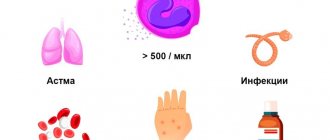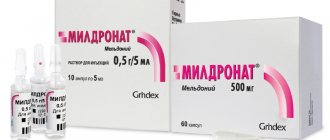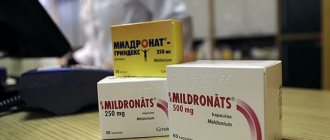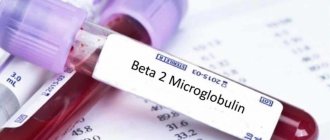30.12.2020
Oxygen deficiency in the body can become a serious problem, since its presence is vital for the functioning of all systems and organs. If there is little oxygen in the blood, all tissues suffer and metabolic processes are disrupted. A person feels tired and depressed, lethargic and weak, and with prolonged hypoxia, serious diseases can develop. Let's look at the main signs of oxygen deficiency and ways to normalize its level in the blood.
Introduction
The heart is an organ that works throughout life without stopping. Over 70 years, it makes about 3,000,000 contractions. To perform such colossal work, it needs nutrition and oxygen, which are supplied through a network of coronary arteries. If disturbances occur in this network, the heart muscle begins to “starve”, this leads to unpleasant sensations and poses a danger to life.
In the last 100 years, the incidence of cardiovascular diseases has increased due to the consumption of large quantities of sweet and fatty foods, fast food, decreased mobility, smoking and stress.
In the practice of a cardiologist, one has to deal with myocardial hypoxia in patients. Most complain of squeezing pain behind the sternum. The doctor examines, identifies the causes, prescribes additional diagnostics and selects treatment: medicinal, surgical or complex, depending on the degree of development of hypoxia.
Additional preventative measures
The first and surest remedy is regular walking; fresh air has a beneficial effect on the body and will provide the necessary amount of oxygen. It is also important to constantly ventilate the living space.
Traditional medicine is also used to help; tinctures of woodlice or hawthorn, as well as birch sap (about one liter per day), are considered effective.
You definitely need to change your lifestyle: replace sedentary activity with active sports (jogging, race walking, cycling), get rid of bad habits (including passive smoking).
Fact! Calmness and emotional balance are the last, but very important stage in the treatment and prevention of cardiac hypoxia!
Causes
- Cardiac ischemia. A common cause of cardiac hypoxia. An atherosclerotic plaque appears in the walls of the heart vessels, which partially or completely blocks the lumen of the arteries. The organ does not receive oxygen and nutrition, which leads to hypoxia.
- Thrombus. Formed when atherosclerotic plaques rupture. They block the artery and lead to sudden and severe ischemia of the muscle, threatening a heart attack. Less commonly, a blood clot enters the heart from other organs.
- Spasm of the arteries of the heart. Temporary contraction of the muscles in the wall of the vessel slightly reduces or blocks the flow of blood to the organ. This is a rarer cause of ischemia.
A person experiences unpleasant manifestations of hypoxia when:
- severe emotional stress;
- inadequate physical activity;
- cold ambient temperature.
I had to examine patients who complained of chest pain when going outside in winter, at a temperature of -20ºC.
It is important to know the possible causes of hypoxia in order to avoid the occurrence of severe heart pathologies.
How to replenish oxygen deficiency
Do you remember where it’s easiest to breathe?
Right! In a forest or park. Especially if it is located at a decent distance from industrial cities. The air there is completely different, the trees purify it. Therefore, the first advice: walk as often and as much as possible, get out into nature. In the forest belt, the air is naturally saturated with oxygen.
An adult tree “releases” 118 kg of oxygen per year, which provides safe respiratory therapy for a family of 2 people. You always return from a walk refreshed, feeling a surge of vivacity and energy.
But what about those who don’t have a park nearby and don’t have the opportunity to go into the forest often? There is a way out in such cases too! Oxygen inhalations will help quickly saturate the body with the necessary oxygen. They are carried out using a special oxygen cartridge.
Risk factors for the development of myocardial hypoxia
- Smoking. Nicotine damages the inner wall of blood vessels. A cholesterol plaque forms in the lumen, which leads to a slowdown in blood flow. This bad habit increases the risk of blood clots in the coronary vessels. Keep in mind that passive smoking also carries risks.
- Studies have shown an association between type 1 and type 2 diabetes and an increased risk of myocardial ischemia.
- Arterial hypertension. Increased pressure in blood vessels aggravates atherosclerosis. Hypertension is often inherited. If your parents or grandparents have had similar episodes, monitor your condition carefully and see a specialist regularly.
- High levels of cholesterol in the blood , which is the main component of atherosclerotic plaque. An increase in the “bad” fraction (low-density lipoproteins, LDL) occurs with inherited metabolic disorders or a diet high in cholesterol and saturated fat (fast food).
- High levels of triglycerides and other fats in the blood. This is a risk factor for the development of atherosclerosis of the heart vessels.
- Obesity. Leads to the development of arterial hypertension, increases the chance of developing diabetes, increases the level of “bad” cholesterol in the blood and leads to myocardial hypoxia.
- Waist circumference. More than 89 cm in women and 102 cm in men is a sign of an increased risk of heart disease.
- Lack of physical activity. The absence or small amount of this component of health has been proven to affect cholesterol and triglyceride levels in the blood. Aerobic exercises (fast walking, running, swimming) are recommended to reduce the risk of myocardial hypoxia and heart attack. Sports activity reduces arterial hypertension.
How to increase oxygen at home: methods for preventing hypoxia
Now we will focus on long-term methods of oxygenating the blood, aimed at overall improvement of well-being and prevention of hypoxia.
- Do breathing exercises
. It can help you achieve longer breathing patterns and increase the volume of your lungs used for breathing. By the way, swimming, vocal classes and even yoga have a good preventive effect. Please note that breathing exercises have contraindications. Discuss this treatment option with your pulmonologist. - Do breathing exercises.
It can help you achieve longer breathing patterns and increase the volume of your lungs used for breathing. By the way, swimming, vocal classes and even yoga have a good preventive effect. Please note that breathing exercises have contraindications. Discuss this treatment option with your pulmonologist. - Stop smoking
. Even passive smoking, i.e. Inhaling tobacco smoke from a smoker near you causes serious damage to the lungs and negatively affects the alveoli. - Get outdoors more often.
If you live in an area with good environmental conditions, get into the habit of walking for at least 15-20 minutes every day. If walking in places without dust and carbon dioxide is impossible, try to create favorable conditions at home: regularly wipe the dust, plant more plants, use air purifiers and humidifiers. - Drink more water
. Firstly, it thins the mucus in the respiratory tract and facilitates the removal of phlegm. Secondly, it thins the blood. It is advisable to drink in small sips separately from meals. The water should be clean, without additives, at room temperature. - Eat foods rich in iron
. This is an easy way for those looking to increase their blood oxygen levels at home and improve their overall well-being. The fact is that a high level of hemoglobin is important for saturating arterial blood with oxygen, and anemia is one of the causes of hypoxia. What foods are rich in iron? Buckwheat, beans, carrots, mushrooms, pomegranates, blueberries, beef, liver. - Give yourself oxygen therapy courses
. The procedure has virtually no contraindications, and the effect on the body is amazing: the immune system is strengthened, metabolism is accelerated, toxins are eliminated, the nervous system calms, sleep quality improves, vitality increases, etc. Oxygen therapy at home can be carried out by inhaling oxygen from oxygen cylinders or taking oxygen cocktails.
The Prana company produces and sells oxygen cylinders with a capacity of 8 to 16 liters. Inside there is a mixture of nitrogen (20%) and oxygen (80%), which does not dry out the respiratory tract, is tasteless and odorless. There are options for cans with an individual mask included. Affordable cost, long service life, convenient lightweight packaging make KISLOROD oxygen cylinders the optimal choice for relieving symptoms or preventing hypoxia and increasing oxygen levels in the blood.
Kinds
- Ischemic hypoxia (cardiac) – caused by a decrease or disruption of blood flow in the arteries.
- Systemic hypoxia (cardiac) occurs when the body does not receive enough oxygen. For example, in case of obstruction of the respiratory tract or in high altitude conditions.
- Anemic hypoxia is an option when there is enough oxygen, but the ability of the blood to carry it is reduced. For example, with iron deficiency anemia. In such situations, no special treatment for hypoxia is required, in addition to correcting iron levels with the necessary drugs.
- Histotoxic hypoxia is an option when, with normal blood oxygen levels and the intact ability of hemoglobin to carry it, the functions of cardiac muscle cells are impaired and oxygen is not used. For example, in case of potassium cyanide poisoning.
What is saturation
In order to understand how to increase oxygen in the blood at home, you will have to understand several terms. So, blood saturation 0₂ (saturation, Sp0₂) is an indicator that determines the amount of oxygen circulating in the bloodstream. This value is relative and is expressed as a percentage. Normal saturation for an adult is 95-100%. This means that the body receives enough oxygen to function. The easiest way to measure oxygen levels in the blood is to use a pulse oximeter: this is a small device that attaches to your index finger and determines saturation within 1-2 minutes.
A drop in blood oxygen saturation is most often caused by respiratory diseases, such as pneumonia, chronic obstructive pulmonary disease (COPD), bronchial asthma, etc. If saturation drops to 90-95%, the patient may be faced with the question of how to increase oxygen in the blood at home, but when the value drops below 90%, you need to go to the hospital. A decrease in Sp0₂ may be accompanied by shortness of breath, fatigue, weakness, cardiovascular problems, cognitive decline, fainting and more serious problems.
Diagnostics
To identify myocardial hypoxia, the doctor will conduct an examination. First, he will collect anamnesis, then examine you.
After this, he will recommend the following diagnostic measures:
- Taking a cardiogram (ECG). Special suction cups are placed on the skin and the electrical activity of the heart is recorded. Some changes in the film, such as diffuse changes in the apical region of the myocardium, indicate disturbances in blood flow (such as left ventricular hypoxia).
- Echocardiogram (EchoCG). A special ultrasound machine is placed on the chest, and the doctor receives a video image of the heart. Using the method, areas of diffuse changes in the myocardium and disturbances in heart contractions are identified.
- Scintigraphy (nuclear scan). This is the most informative and expensive method for diagnosing cardiac hypoxia. A small amount of radioactive substance is injected intravenously. By assessing the degree of saturation of the myocardium with the isotope, we can draw a conclusion about the depth of damage.
- Coronary angiography. A special dye contrast agent is injected into the blood vessels of the heart. Using an X-ray machine, a series of images (angiograms) are obtained, which analyze the blood flow in the arteries and evaluate the signs of myocardial hypoxia.
- CT scan of the heart. The presence of calcification is assessed - a reliable sign of arterial atherosclerosis. The condition of the vessels is also analyzed using CT angiography.
- Stress test. You walk on a treadmill at a fast pace or pedal an exercise bike, and machines record your breathing rate, heart rate and blood pressure levels. The heart begins to beat faster in response to physical activity and stressful conditions. As a result, it becomes possible to identify problems that would not normally be observed.
Signs of lack of oxygen
Hypoxia varies in intensity and severity. Based on these characteristics, it is divided into:
- chronic,
- spicy,
- lightning fast.
Lightning hypoxia occurs as a result of mechanical suffocation, allergic edema and other factors. Acute hypoxia is slightly less intense and can also develop due to partial occlusion of the airways, for example, with bronchitis with obstruction. Chronic hypoxia can last for years, and often a person does not even realize that there are problems with the concentration of oxygen in the blood. However, this is a very dangerous condition that directly or indirectly affects all body systems and provokes many serious diseases.
The most characteristic signs of oxygen starvation in adults are as follows:
- frequent dizziness;
- headaches and migraines;
- drowsiness, lethargy, weakness;
- tachycardia;
- pale skin;
- blue discoloration in the area of the nasolabial triangle;
- insomnia;
- increased irritability and tearfulness;
- low blood pressure;
- tremor of hands and feet;
- nausea;
- lack of coordination;
- swelling.
It is not at all necessary that all the symptoms of oxygen starvation in adults will be present at once: hypoxia is insidious in that the manifestations can be blurred and have different frequency and intensity. Nevertheless, the presence of several signs from this list is a good reason to pay attention to your health and check the level of oxygen in your blood. It is possible that you suffer from chronic hypoxia.
Treatment
The principle of treating myocardial hypoxia is to improve blood flow in the heart muscle. The doctor selects drug therapy, surgery or an integrated approach depending on the severity of the condition.
The treatment regimen is individual, so self-medication is not recommended.
Medications
- "Aspirin". A drug that reduces the ability of blood to form blood clots. Reduces the risk of coronary artery blockage. It is used for the prevention of acute myocardial infarction, stroke, acute cerebrovascular accidents, thrombotic complications during surgical operations, and angina pectoris.
- Beta blockers. They relax the myocardium, slow the heartbeat and lower blood pressure, which facilitates blood access to the heart.
- Calcium channel blockers. They relax and dilate blood vessels, increase blood flow, and slow down the heart rate.
- Nitrates, for example, Nitroglycerin. Temporarily expand the lumen of blood vessels, improve blood flow in the arteries and veins of the heart.
- Cholesterol-lowering agents. These are statins, bile acid sequestrants, nicotinic acid compounds and fibrates.
Statins (Atorvastatin, Fluvastatin, Lovastatin and others) reduce the level of “bad” cholesterol by 25-60% and increase its “good” fraction. Most current guidelines recommend statins as the drug of choice for patients with any form of atherosclerosis, people 40–75 years of age with diabetes and high cholesterol, without diabetes, with a 10-year risk of developing atherosclerotic lesions >7.5%.
- Angiotensin-converting enzyme inhibitors (ACEIs). Relaxes blood vessels and reduces blood pressure. Most often, it is prescribed to patients with arterial hypertension or diabetes, in addition to myocardial hypoxia.
- "Ranolazin" ("Ranexa"). Relaxes the heart arteries and reduces angina.
Surgical methods
- Angioplasty and stenting. A catheter (a thin, long tube) is inserted into the narrowed area of the artery. A small balloon is inflated to expand the lumen. A wire tube (stent) is then inserted to prevent re-stenosis. The operation is not open, it is performed through vascular access.
- Coronary artery bypass surgery. The surgeon takes a vessel from another part of the body and creates an additional path for blood to bypass the blocked section of the bloodstream. The operation is indicated for significant vasoconstriction and severe hypoxia.
Beneficial effect of oxygen inhalation
- Increases the tone and activity of the body mentally, sexually and physically.
- Maintains health in environmentally unfavorable living conditions.
- Stimulates metabolic processes.
- Accelerates the replenishment of energy reserves.
- Recovery from injuries and operations is faster.
- Strengthens and tempers the immune system.
- Eliminates symptoms of motion sickness in transport.
- Normalizes night sleep and rest, helps cope with insomnia.
- Increases stress resistance.
- Improves the functioning of internal organs, blood vessels and systems.
- Improves the quality of life and has a beneficial effect on the psycho-emotional state.
Doctor's advice
To reduce the likelihood of developing heart disease, doctors recommend lifestyle changes:
- Stop smoking. Discuss discontinuation strategies with your doctor and avoid a passive process.
- Improve comorbid conditions (diabetes and hypertension). These diseases increase the risk of myocardial hypoxia.
- Switch to a healthy diet. Reduce saturated fat and increase whole grains, fruits and vegetables in your diet. Control your blood cholesterol levels.
- Doing physical exercise. Consult with a specialist about safe aerobic and strength training exercises to improve blood flow to the heart.
- Maintain normal weight. If you are overweight, ask your doctor about suitable weight loss options.
- Reduce stress. Use special techniques for muscle relaxation and deep breathing.
Visit your doctor regularly for physical examinations. The main risk factors for myocardial hypoxia (high cholesterol, blood pressure and diabetes) are asymptomatic in the initial stages. The earlier pathology is detected and treatment is prescribed, the higher life expectancy and better heart health.
What is the threat of the condition?
Myocardial hypoxia increases the risk of life-threatening complications.
- Myocardial infarction (heart attack). When the blood flow in the vessels is completely blocked, the lack of blood and oxygen causes an attack, and then the death of part of the muscle. This complication is very serious and can be fatal.
See your doctor immediately if you experience symptoms of prolonged or severe chest pain! Call an ambulance. The doctor will diagnose and begin treatment as early as possible.
- Heart rhythm disturbances (arrhythmias). They lead to a weakening of contractile function and threaten life, as they increase the risk of stroke.
- Heart failure. During a heart attack, hypoxia of the left ventricular myocardium can damage the heart muscle and impair its ability to pump blood throughout the body. In this case, the organ cannot cope with the load. Swelling and shortness of breath occur, and the risk of death increases.
How is oxygen inhalation performed?
The oxygen cartridge is equipped with a simple, convenient dispenser. Thanks to the dispenser, the cylinder can be used by several people.
Individual use of a can with a mask provides control over the flow of the mixture and prevents the ingress of impurities from the surrounding air. The procedure is performed with the help of a mask for children, the elderly and people with disabilities.
If a person has a serious illness and requires constant oxygen therapy, it is recommended to purchase not an oxygen canister, but a concentrator. A special device that produces high concentration oxygen from 1 to 3 liters per minute. In this case, the patient breathes through a mask or nasal cannula. The number and duration of procedures is determined by the attending physician. This therapy is prescribed for patients with pulmonary pathology, heart disease, cancer, and nervous system disorders. Sessions can be performed at home or in a hospital setting.
conclusions
Myocardial hypoxia is a leading cause of mortality worldwide. It occurs in young and old people, men, women, and people with various diseases. It is especially often provoked by coronary heart disease. Hypoxia damages the muscle and disrupts the function of pumping blood. A terrible consequence of a sudden and severe blockade of the coronary arteries is a heart attack. Other complications: serious rhythm disturbances, arrhythmias, and heart failure.
Symptoms and treatment of myocardial hypoxia are what every person who cares about their health should know. The most striking symptom is angina pectoris, severe chest pain. It feels dull, squeezing, heavy. The pain radiates to the left arm, shoulder blade, back, neck, lower jaw. The pain appears with severe stress, physical activity, and lasts 1-5 minutes.
Modern doctors have diagnostic and treatment methods with proven effectiveness in their arsenal. The goal of therapy is to restore blood flow to the heart. Medicinal and surgical methods are used: angioplasty and stenting of coronary arteries, bypass surgery.
What is he like?
The oxygen cartridge contains a concentrated breathing mixture consisting of 80% oxygen and 20% nitrogen. This composition ensures maximum absorption of oxygen during inhalation. Cans are available in different volumes: 8, 12 and 16 liters. They weigh from 140 to 180 grams. The oxygen cartridge does not take up much space in your purse, which allows you to carry it with you.
Clinical case
In practice, there are cases when patients with moderate myocardial hypoxia do not have obvious symptoms.
Doctors call this option “silent ischemia.” But more often, patients come with complaints of dull, squeezing, severe pain in the chest, radiating to the left arm, shoulder blade, jaw, neck, or back. This is angina - which occurs when there is insufficient blood flow to the heart. Characteristic feature: when the doctor asks to describe the nature of the sensations, the person brings a clenched fist to his chest. It was precisely this symptomatology that was called “heart toad” in the old literature.
The pain often appears during physical activity and stress and lasts 1-5 minutes.
Development of the disease and the main signs of its manifestation
For this pathology, several stages of development have been identified, and these are:
- light;
- moderate;
- heavy;
- critical (deadly).
For each stage of myocardial hypoxia, symptoms and treatment are different.
The very first sign is an increased heart rate (called tachycardia). This occurs due to the fact that the heart tries to normalize the supply of oxygen to the organs. Then contractility begins to decrease. As a result, arrhythmia of the entire myocardium occurs, which can lead to ventricular fibrillation.
Characteristic symptoms for moderate myocardial hypoxia are a decrease in the body's performance, general fatigue, drowsiness, irritability, and increased sweating.
The next symptom of myocardial hypoxia is a surge in pressure: first it increases, and then there is a sharp decrease. Such a difference leads to collapse not only of the heart, but also of the respiratory system. In this case, shortness of breath and heavy breathing appear, followed by cyanosis (the appearance of a bluish appearance of the body). As a result, the body consumes less oxygen from the environment, breathing becomes less frequent and may stop.
At a critical stage, all of the listed symptoms may not appear; the attack occurs at lightning speed and leads to respiratory and cardiac arrest. This stage is the most dangerous.
We should also not forget that myocardial hypoxia can occur in two forms: acute (in which all the signs of the disease appear within a few hours and can result in death) and chronic (in which the development of the disease lasts several years).











